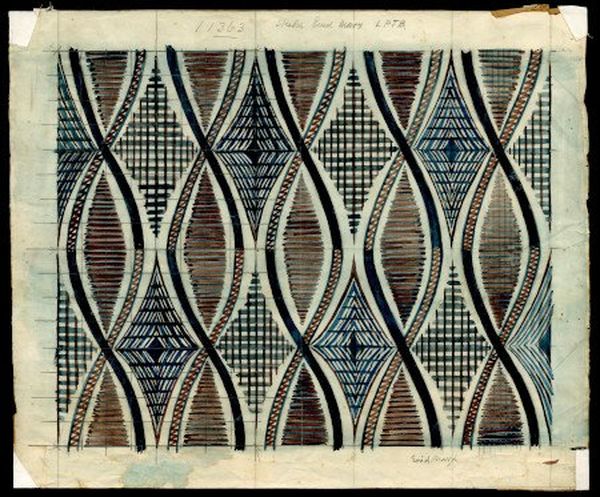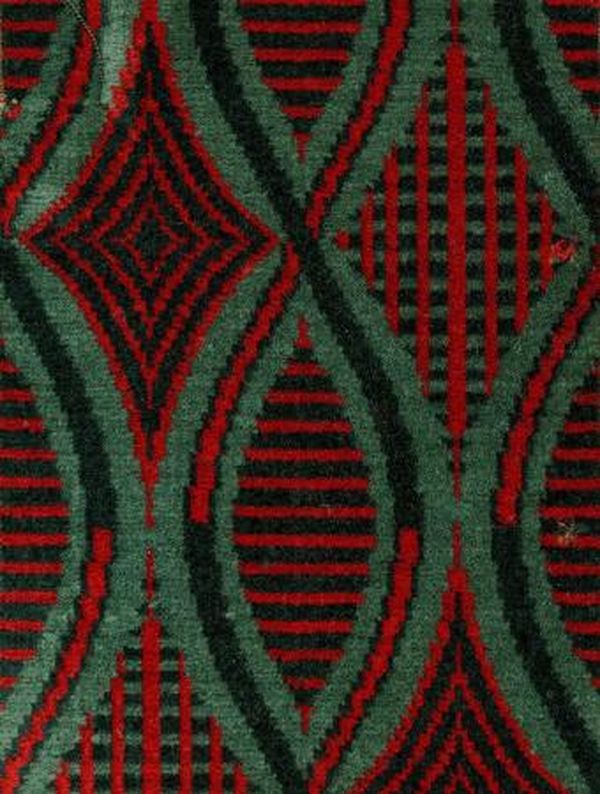Enid Crystal Dorothy Marx (1902 – 1998) British textile and graphic designer. Enid Marx was one of the most influential pattern designers of the twentieth century, though full credit for her work was denied for a long time due to her early connections with the Arts and Crafts movement and her own promotion of the design qualities of folk art.
Education
She studied painting and wood engraving at the Royal College of Art in London, as well as at the Central School of Arts and Crafts.
Biography
She established her own textile printing workshop after working with Barron and Larcher from 1925 to 27. Her work drew the attention of Gordon Russell, who aided her career. She created patterned papers for books and wrapping, book jackets for Chatto and Windus and Penguin, illustrations, trademarks, printed and woven fabrics, wallpapers, posters for London Transport, Shell calendars, ceramics, plastics, and postage stamps.

London Transport 1937
She created a line of Modern moquette fabrics for London Transport in 1937. The fabric was durable and did not show dirt easily, but it was also modern and appropriate for electric transportation. This brief was difficult to complete because the textile manufacturers refused to provide all of the technical information she required. Frank Pick, London Transport’s commercial manager, had to step in.
Margaret Lambert, she co-wrote the book When Victoria Began to Reign (1939) on British folk art.
She was a member of the Utility Furniture Advisory Panel from 1944 to 1947, designing a series of upholstery fabrics as well as the majority of the Utility furniture while working with very limited materials. She designed fabrics for Edinburgh Weavers and some that she printed herself; one of her fabrics produced by Morton Sundour was featured at the 1951 ‘Festival of Britain.’ Her utilitarian and richly textured textile designs featured muted abstract patterns of chevrons, stripes, stars, and circles.
Later career
Marx’s repertoire expanded to include plastic laminates and synthetic fabrics in the 1950s. She says: ‘Designing for synthetic textiles, for example, is far more difficult than designing for natural ones; with synthetics it is necessary to discover, or introduce, qualities to validate them in their own right; they have for too long been used purely imitatively’
Sample of Works











Recognition
In 1944, she was elected Royal Designer for Industry. She participated in the 1946 ‘Britain Can Make It’ exhibition and the 1951 ‘Festival of Britain.’ Her work was the subject of an exhibition at the CamdenArts Centre in London and included in the ‘CC41: Utility Furniture and Fashion, 1941 – 1951 ‘exhibition at the Geffrye Museum in London.
Sources
Byars, M., & Riley, T. (2004). The design encyclopedia. Laurence King Publishing.
Dormer, P. (1999). The illustrated dictionary of twentieth-century designers: the key personalities in design and the applied arts. Greenwich Ed.
Enid Marx and Utility Textiles. Warner Textile Archive. (2020, February 4). https://www.warnertextilearchive.co.uk/blog/enid-marx-and-utility-textiles/.
Why the textile designer Enid Marx matters today. (n.d.). https://www.craftscouncil.org.uk/stories/why-textile-designer-enid-marx-matters-today.
Wikipedia contributors. (2021, March 29). Enid Marx. In Wikipedia, The Free Encyclopedia. Retrieved 20:20, May 9, 2021, from https://en.wikipedia.org/w/index.php?title=Enid_Marx&oldid=1014868551\

Comments are closed, but trackbacks and pingbacks are open.